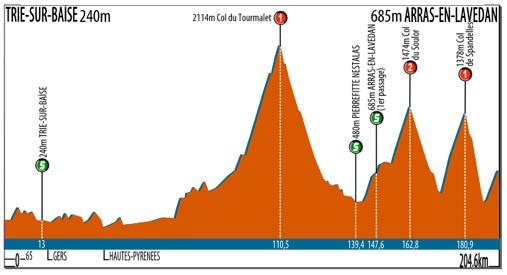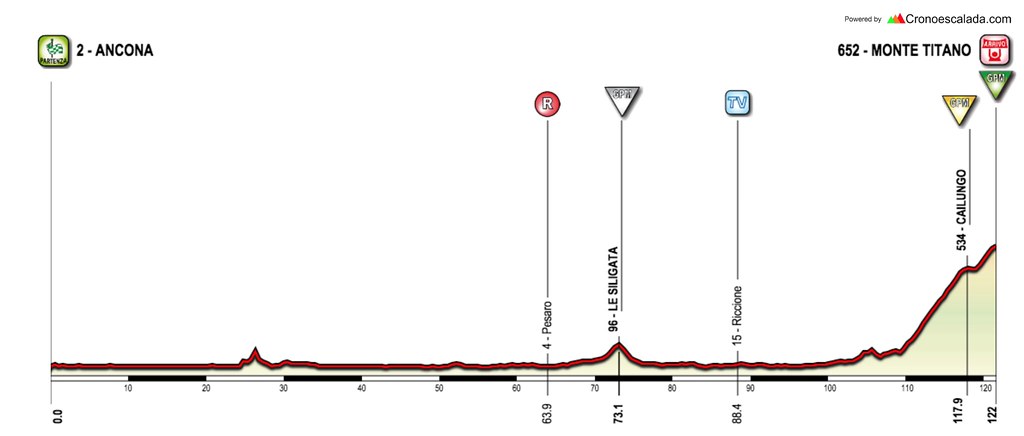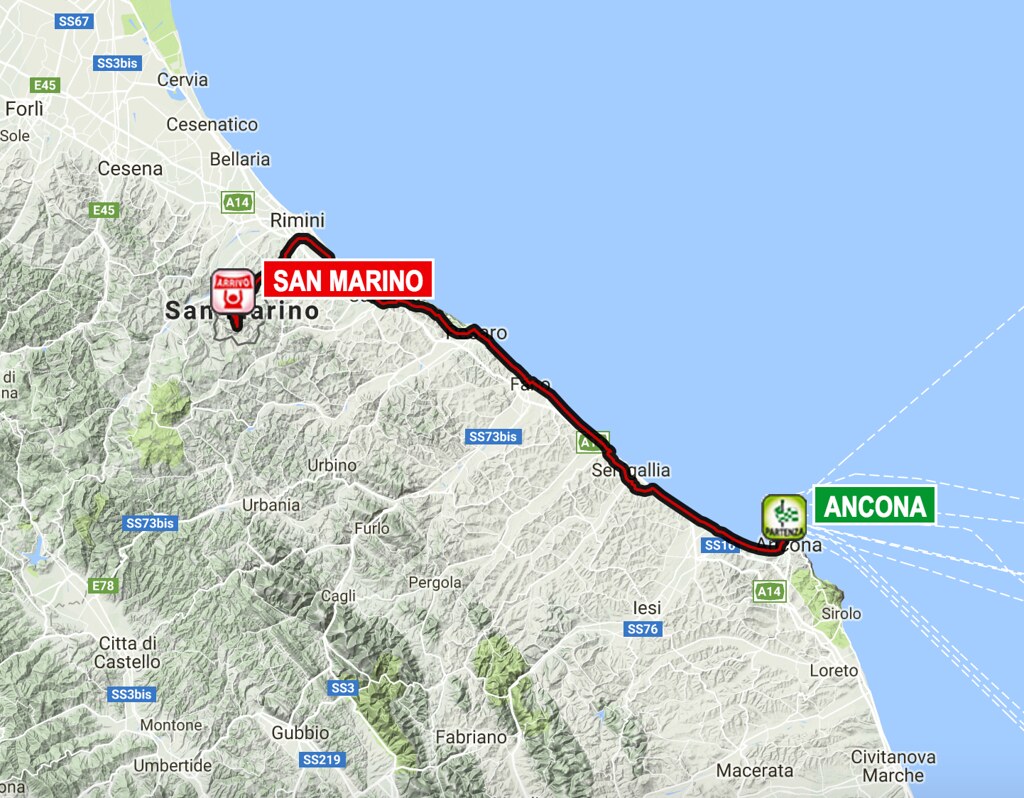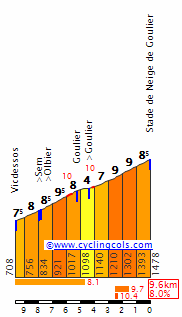@fauniera, there's quite a lot of really fine quality sterrato trails just north of Ermita de la Trinitat. I see a roughly 20km long track from Begues to Sant Pere de Ribes (north of Sitges) supposedly called Camí Parc del Garraf which is almost entirely on sterrato. This track should end roughly 8km from the finish line. This entire stretch of road is on streetview. There also seems to be a couple of alternative tracks nearby which may work as well.
My next Tour de France entry ended up being way too long, but there's a lot to talk about. Also thank god i didn't watched the Nice stage as i would probably ragequit. Also, is it me, or does Pinot look a bit bulkier than usuall? Maybe that's just my awful eyes.
Last stage:
click
Emm... this was supposed to happen...
Pau - Peyragudes-Les Agudes.
Bagnères-de-Luchon – Foix.
I took 2 days off from posting to complete these 2 stages below. I won't talk about the first one as it's just a copy of 2011 stage. It's purpose is to have a proper MTF and to maybe slightly wear of some legs for the next stage. I expect a similar scenario to 2011 and 2015 stages – a roughly 10-man dash to the finish line.
Tour de France by railxmig – stage 15. Saint-Gaudens - Plateau de Beille, 169km, ~4100 asc.
Climbs:
Col de Portet-d'Aspet - 4,3km, 9,7%, 2 cat. 1069m
Col de la Core - 14km, 5,8%, 1 cat. 1395m
Col de Latrape - 5,5km, 7,4%, 2 cat. 1110m
Col d'Agnès - 10km, 8,2%, 1 cat. 1570m
Port de Lers - 3,8km, 5,5%, 3 cat. 1517m
Plateau de Beille - 15,8km, 7,9%, HC cat. 1780m
Start: Saint-Gaudens, Rue des Compagnons du Tour de France
Km 0: Miramont-de-Comminges, D905, 3,3km from the start
Finish: Plateau de Beille
Sprint: Castillon-en-Couserans, Avenue Noël Peyrevidal, 250m straight
Feed zone: Seix, Route d'Espagne
Start - km 0:
Rue des Compagnons du Tour de France - Rue de la République - Boulevard Louis Pasteur - Boulevard Eugène Azémar - Boulevard Jean Bepmale - Place de Barbastro - Avenue Henri Montagut - Avenue du Président Kenned - Avenue André Bouery - Pont de Miramont-de-Comminge - Miramont-de-Comminges, D905
Tour de France by railxmig – stage 16. Foix - Llívia, 212km, ~3200m asc.
Climbs:
Col de Montségur - 4,7km, 8%, 2 cat. 1059m
Col de Pailhères - 16,7km, 7,3%, HC cat. 2001m
Col de Puymorens - 28,1km, 4,2%, 1 cat. 1920m
Côte de la Griole - 4,5km, 7%, 2 cat. 1559m
Start: Foix, Allées de Villote
Km 0: Foix, Route d'Espagne, 3,3km from the start
Finish: Llívia, Avinguda de Catalunya, 140m straight
Sprint: Quillan, Boulevard Charles de Gaulle, 200m straight
Feed zone: Saint-Martin-Lys, D117
Start - km 0: Allées de Villote - Cours Bouycheres - Avenue de Barcelone - Route d'Espagne
Sterrato:
Estavar - 1,2km
La Griole - 3,2km
Carrer de Llívia España - 2,6km
I had two versions of this stage prepared. I initially rejected the idea i finally went with. While the first one with Pailhères and Puymorens was easier to draw it was probably an easier version of this stage. I abandoned the realistic part of this race long time ago so i just decided to have fun and not care about anything. My philosphy of designing a stage/race was always heavily based on the realistic nature of such piece. This time i decided just to take the oppurtunity.
I don't know if anyone ever came up with such an idea to finish in Llívia in such fashion but i guess i'm not the first one. Sadly the search engine in this forum seems to be a bit wonky so i don't know if such a finish ever featured in this thread. Maybe someone in a Vuelta allready did such thing.
Start in Foix.
Previously i planned a finish in
Foix. Now it has a start. It's located on the other side of Allées de Villote, basically parallel to 2012 and i assume 2017 finish. Foix is a former Roman fortress (later it evolved into an actual castle) and an abbey from XII c. In the middle ages it was a capital of a small county just south of Toulouse. The main sights are Château de Foix from XIII-XV c. and Abbatiale Saint-Volusien from XII c.
Château de Foix.
First roughly 80km are on the Foix – Perpignan road. There's a small detour to quite steep
Col de Montségur on top of which are the ruins of Château de Montségur from around XIII c. It had strong connection with Cathars. In 1233 it became sort of a capital of Cathars. It was
heavilly damaged during the Albigensian Crusade.
Profile of Col de Montségur.
Château de Montségur.
The descent from Montségur will lead to Puivert where there's another Cathar castle (Château de Puivert) from XII c. Further down the road is
Quillan, where an intermediate sprint is located. Not far away is a feed zone, located just after
Gorges de la Pierre-Lys. Soon riders leave the Perpignan road in Pont d'Aliès (Axat) and turn towards the 2nd climb of the day –
Col de Jau.
First roughly 10km to Sainte-Colombe-sur-Guette in the l'Aiguette valley are false-flat. The main ascent is 13,9km long at 6,6% and it's cat. 1. The road is quite narrow and not in best of conditions. This climb was used in Tour a couple of time, last time in 2001 with Laurent Roux first on top. While it's not an easy climb (a strong cat. 1) the descent should be the main concern. It's not steep with majority of the first 10km at 6-8% and max 10% but with 23km of twisty (18 serpentines in span of 6km) and narrow roads it's highly dangerous.
Profile of Col de Jau.
One of the serpentines on the descent from Col de Jau.
The descent leads to Catllar – a small town just north of Prades.
Prades is the capital and biggest city of Conflent, a historic region at the entrance to Vallée de la Têt – one of the main valleys of Pyrénées-Orientales. Riders will stay in this valley for the next 15km going on N116 Perpignan – Lleida road and leave it in Olette.
Picturesque cliffs in the Têt valley.
In
Olette riders leave the Lleida road turning into Vallée du Cabrils and start the next climb of the day –
Col de la Llose (or Coll de la Llosa in Catalan). Col de la Llose is sort of a harder version of Puymorens while Jau was an easier version of Pailhères. Jau is not really important to this stage outside of its descent. Llose however is very important to this stage. It's topping at over 40km from the finish line but it should be very influential to the last 20km.
First 11km of the ascent are irregular with even short bits of descents and 12% slopes. Next roughly 13,5km to the top are much more regular with slopes between 5-7%. Llose's task is to create a selection good enough to get rid of a majority of riders, who are good on rough terrain. These guys are usually quite bulky so their climbing capabilities are limited. The lesser amount of people, who are used to ride on dirt roads the bigger gaps could be generated in the last kms of this stage. It will be softpedalled, but i still expect a roughly 40-man group at the top. While the road up is narrow and not in the best of conditions thankfully the descent is short and relatively easy.
Profile of Col de la Llose.
Road to the top of Col de la Llose.
The descent will lead to
Mont-Louis – the entrace to Haut-Cerdagne from Vallée de la Têt. During the middle ages it was understandably a major citadel defending Cerdagne from the valley. Nowadays the citadel is listed in UNESCO World Heritage Sites list.
Citadel of Mont-Louis.
Next roughly 17km to Llívia are in Haut-Cerdagne back on N116. The race will go close to the main ski area on the French side of Pyrénées-Orientales –
Font-Romeu. There are a couple of roads and places for a finish in the area. The highest and hardest one is to the biathlon stadium in Mollera des Clots at 2040m. These climbs are not hard (cat. 3 or easy 2) but combined with Col de la Llose (like i think in the crazy 1976 stage) it can be a quite significant finish. Riders will leave N116 for good in Saillagouse and soon after reach
Estavar – a small town adjacent to Llívia, but on the French side of the border.
Font-Romeu.
Just today i managed to find yet another fine
dirt road near Llívia. This one is very important as it nullifies the need to cross the finish line from the other side. This section connects Estavar with the northernmost peak of Llívia, basically bypassing the city from north. I assume this road is used mainly for mining as there are some small sand heaps. Maybe something with clay, i don't know. This road seems to be quite rough, with some amount of debris but it should be easily cleared before the race.
Pseudo-lap around Llívia.
Dirt section from Estavar to Llívia.
Llívia was the historic capital of Cerdagne. It was a quite important citadel in the early middle ages but nowadays it's a rather small town. It became an exclave thanks to the Treaty of Pyrenees in 1659 to end a 25 years war between France and Spain. The main sights are a medieval pharmacy and museum Farmàcia Esteve from XVII c and the remains of Castell de Llívia on top of a nearby hill, from the early middle ages.
Llívia.
The sort of lap around Llívia is very difficult. After the initial dirt section there's immediately a cat. 2 climb to
la Griole – a camping site on the French side of the border near Targassonne. It's 4,5km at 7% with some bits of over 10% reaching even
16%. It's a quite narrow road with a times shaky surface quality. Last roughly 3km of this climb are on
dirt. Judging from the satelite images it should be in a fine state – not Strade-Bianche quality but better than Tro-Bro Léon. This dirt section finishes when the road reaches D618 on a small plateau roughly 200m after the KOM. The top of this climb is roughly 13km from the finish line.
Profile of Côte de la Griole.
Road up to la Griole.
From the top there's a roughly 10km long, nice, easy, wide and shallow descent on D618 to
Ur. However, that's not the end of difficulties as in Ur riders won't go straight to Llívia but go via an alternate route known as
Carrer de Llívia España. Coincidentally this route is also on
dirt. It seems to be slightly rougher than the one to la Griole with a couple of filled ponds on the satelite images which means potholes. This dirt section is 2,6km long and it ends 1,1km from the finish line.
Carrer de Llívia España.
The run-in is not easy either as it'll require a descend down to N-154 on Carrer Camí Ral and Carrer d'Encorones before the last 720m on wide and nice N-154 to the finish line.
Finish in Llívia.
Llívia has a good amount of sterrato paths to offer. I've used three of them but there are at least two more available. There's a roughly 2km long Carrer Concellabre connecting with D30 in La Solana. There's also a much easier 400m long path directly to D618 on a small plateau above Cereja. I will probably come back to Llívia as it should be a fine place for a hilly/medium mountain one-day race including sterrato and nearby ski stations like Font Romeu and Egat.
I have no clue what will happen on these sterrato bits. It's not Tro-Bro Léon and on paper it's much harder than Strade Bianche. I assume by the time there won't be any specialists in the reduced Peloton. I guess Sky might have the best chance to pose problems with Kwiato and mainly GT keeping things intact. I guess even on a sunny weather the gaps should be noticeable, but i have no clue how big they can be and who will gain the most but the last 20km around Llívia should be very entertaining.
If the weather will be very awful then the alternate route can bypass the dirt bits and go entirely on asphalt with a climb on D33 from Estavar to Egat (Col d'Egat – 7km, 6%, cat. 2) and then a 16km long false-descent to Llívia using the regular N-154 road rather than alternatives. Then it should be a much easier race ending with a 20-30-man sprint.
Now finally back to my original post.
Tour de France by railxmig – stage 17. Muret - Villeneuve-sur-Lot, 199km, ~1300m asc.
Start: Muret, Rue Castelvielh
Km 0: Muret, Route de Rieumes, 3,1km from the start
Finish: Villeneuve-sur-Lot, Avenue d'Agen, 400m straight
Sprint: Verdun-sur-Garonne, Route d'Auch, 5,7km straight
Feed zone: Labastide-du-Temple, Goubet, Route de Lafrancaise
Climbs:
Côte de Saint-Georges - 1,1km, 9,6%, 3 Cat. 180m
Côte de Haut-Castel - 1,8km, 5,9%, 4 Cat. 217m
Côte de Lauzerte - 1,2km, 6,6%, 4 cat. 184m
Côte des Vignals - 2,7km, 4,5%, 4 Cat. 231m
Côte de Terre-Nègre - 2,4km, 4,1%, 4 cat. 254m
Côte de Couyssels - 2,6km, 3,7%, 4 Cat. 230m
Côte de Cap de l'Homme - 3km, 4,1%, 4 cat. 208m
Côte de Lagrémie - 1,1km, 10%, 3 cat. 191m
Start - km 0:
Rue Castelvielh - Rue Clément Ader - Place de la République - Place de la Paix - Place du Languedoc - Avenue Saint-Germier - Boulevard de Lamasquère - Route de Rieumes
Most of this stage comes from an older Fleurance – Marmande stage from my 2nd Tour (the one starting in Avignon). It later evolved into this:
Blagnac – Bergerac.
I finally ended up with Villeneuve-sur-Lot and a quite tough cat. 3 Côte de Lagrémie only 5,5km from the finish line. There might be some GC movement possible but considering it's at the end of this Tour, so the time splits in GC should be relatively big and the next stage is a TT i doubt there will be any GC action. It should be a nice battleground for the breakaway though.
This stage starts in
Muret on Rue Castelvielh. Muret is just south of Toulouse. It may look smallish but it has 25 000 inhabitants. Muret comes from a Roman villa. The main event in Muret's history was a nearby battle in 1213 between Crusaders Simon IV and Catharist, Arangonese and Catalan forces of Peter II. It was one of the main events of the Albigensian Crusade which managed to get rid of Cathars and join the Languedoc to France. Muret once hosted a Tour stage. It was in 2015 to Rodez, which was won by Greg Van Avermaet.
Start in Muret.
Eglise Saint-Jacques de Muret.
This stage goes through the hills of
Lot and
Garonne – mainly
Quercy (a former province) and
Agenais. There's a lot of cat. 4 hills. Last two of them are part of Agenais while the rest is in Quercy. Both these regions are quite known for hilltop towns like Lafrançaise, Lauzerte, Pujols or Penne-d'Agenais. This whole region looks like a more densly forested Tuscany and seeing the architecture of the towns it's really not that far away from Italy.
Centre of Lauzerte.
Montaigu-de-Quercy.
Most of the roads on this stage are nice and wide. The only exception are the last roughly 15km where some narrower bits shows up but nothing really challenging. This stage does use small amount of national roads – N224, which for some reason is national and like 300m of Périgueux – Lourdes N21.
While the very bumpy 50km in Quercy does look a bit intimidating the main action should be held on the last two hills – Côte de Cap de l'Homme and Côte de Lagrémie.
Côte de Cap de l'Homme is quite long but not really special with 3km at 4,1% (max 8%). The main difficulty is
Côte de Lagrémie topping about 5,5km from the finish line. It's 1,1km at a very stable 10% (max 12%). It's on a slightly narrower road but the descent is nice and wide (max 9%). The descent from Lagrémie goes through Pujols and then down to Villeneuve-sur-Lot. The finish line is on Avenue d'Agen, at the end of a 400m straight.
Road up to Côte de Lagrémie.
Villeneuve-sur-Lot comes from Gajac, which was destroyed during the Albigensian Crusade. It lies on the Lot river, which is littered with manor houses and small castles like Château de Favols or Château de la Sylvestrie. Tour de France finished here twice. First in 1996 won by Massimo Podenzana and in 2000 won by Erik Dekker.
Finish in Villeneuve-sur-Lot.
Villeneuve-sur-Lot.
Next 2 stages are very important and because they'll wander aimlessly around Dordogne expect hilly, twisty, narrow and wet roads. Apparently i'm very cynical.
















































































































































































































































































